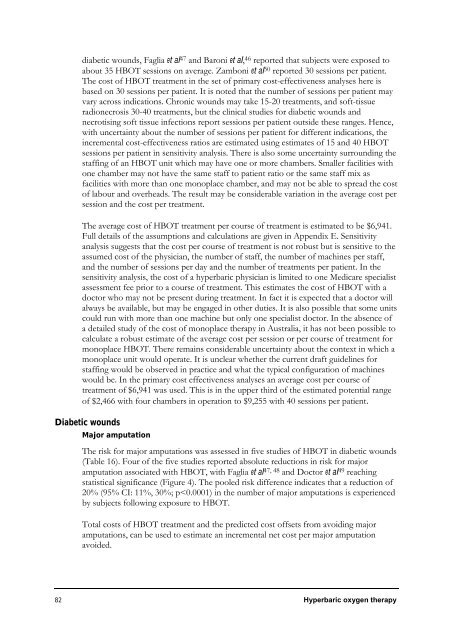Hyperbaric Oxygen Therapy - Hyperbaric Chamber Information ...
Hyperbaric Oxygen Therapy - Hyperbaric Chamber Information ...
Hyperbaric Oxygen Therapy - Hyperbaric Chamber Information ...
You also want an ePaper? Increase the reach of your titles
YUMPU automatically turns print PDFs into web optimized ePapers that Google loves.
diabetic wounds, Faglia et al 47 and Baroni et al, 46 reported that subjects were exposed to<br />
about 35 HBOT sessions on average. Zamboni et al 50 reported 30 sessions per patient.<br />
The cost of HBOT treatment in the set of primary cost-effectiveness analyses here is<br />
based on 30 sessions per patient. It is noted that the number of sessions per patient may<br />
vary across indications. Chronic wounds may take 15-20 treatments, and soft-tissue<br />
radionecrosis 30-40 treatments, but the clinical studies for diabetic wounds and<br />
necrotising soft tissue infections report sessions per patient outside these ranges. Hence,<br />
with uncertainty about the number of sessions per patient for different indications, the<br />
incremental cost-effectiveness ratios are estimated using estimates of 15 and 40 HBOT<br />
sessions per patient in sensitivity analysis. There is also some uncertainty surrounding the<br />
staffing of an HBOT unit which may have one or more chambers. Smaller facilities with<br />
one chamber may not have the same staff to patient ratio or the same staff mix as<br />
facilities with more than one monoplace chamber, and may not be able to spread the cost<br />
of labour and overheads. The result may be considerable variation in the average cost per<br />
session and the cost per treatment.<br />
The average cost of HBOT treatment per course of treatment is estimated to be $6,941.<br />
Full details of the assumptions and calculations are given in Appendix E. Sensitivity<br />
analysis suggests that the cost per course of treatment is not robust but is sensitive to the<br />
assumed cost of the physician, the number of staff, the number of machines per staff,<br />
and the number of sessions per day and the number of treatments per patient. In the<br />
sensitivity analysis, the cost of a hyperbaric physician is limited to one Medicare specialist<br />
assessment fee prior to a course of treatment. This estimates the cost of HBOT with a<br />
doctor who may not be present during treatment. In fact it is expected that a doctor will<br />
always be available, but may be engaged in other duties. It is also possible that some units<br />
could run with more than one machine but only one specialist doctor. In the absence of<br />
a detailed study of the cost of monoplace therapy in Australia, it has not been possible to<br />
calculate a robust estimate of the average cost per session or per course of treatment for<br />
monoplace HBOT. There remains considerable uncertainty about the context in which a<br />
monoplace unit would operate. It is unclear whether the current draft guidelines for<br />
staffing would be observed in practice and what the typical configuration of machines<br />
would be. In the primary cost effectiveness analyses an average cost per course of<br />
treatment of $6,941 was used. This is in the upper third of the estimated potential range<br />
of $2,466 with four chambers in operation to $9,255 with 40 sessions per patient.<br />
Diabetic wounds<br />
Major amputation<br />
The risk for major amputations was assessed in five studies of HBOT in diabetic wounds<br />
(Table 16). Four of the five studies reported absolute reductions in risk for major<br />
amputation associated with HBOT, with Faglia et al 47, 48 and Doctor et al 49 reaching<br />
statistical significance (Figure 4). The pooled risk difference indicates that a reduction of<br />
20% (95% CI: 11%, 30%; p



